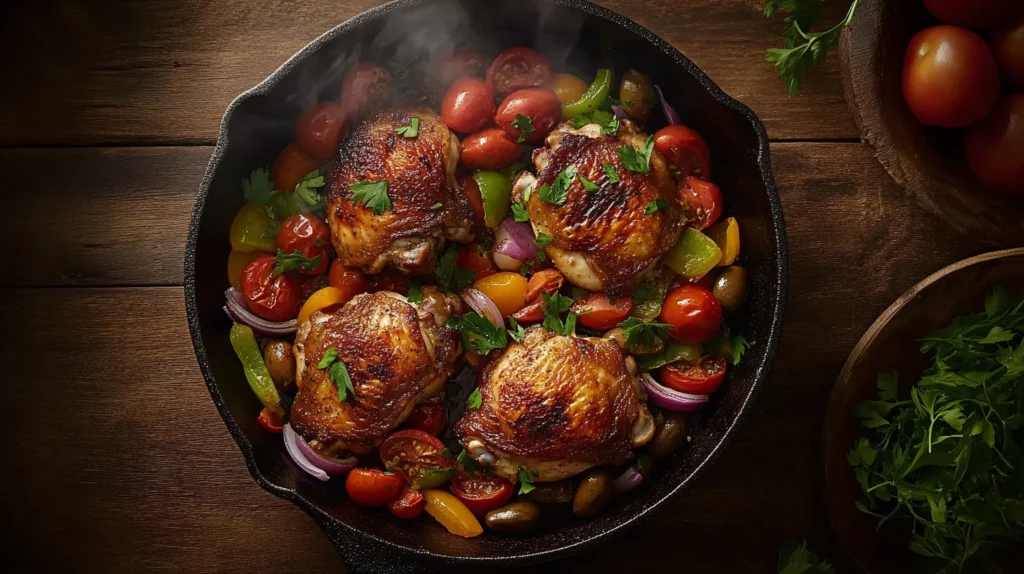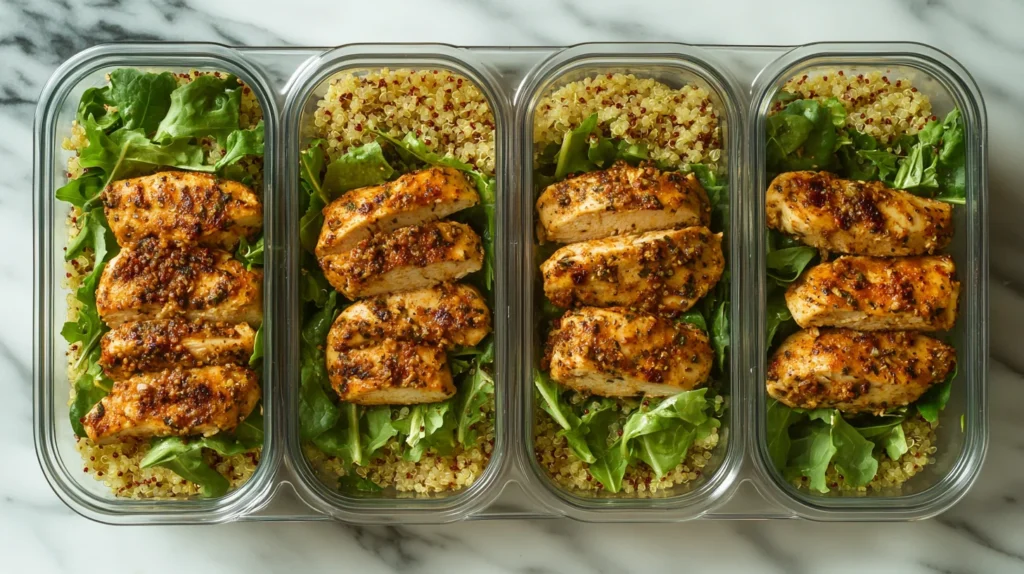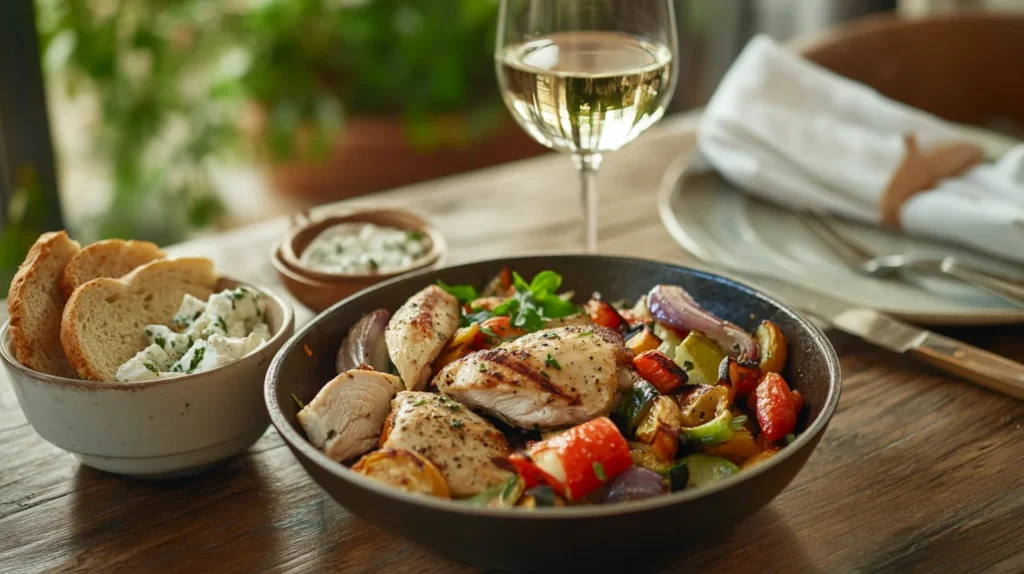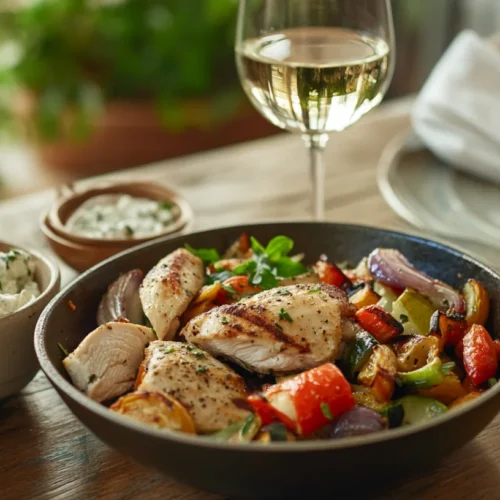If you’re searching for a dish that’s quick, healthy, full of flavor, and easy to clean up after—look no further than the Mediterranean Chicken Skillet. This one-pan wonder brings the sunny, vibrant tastes of the Mediterranean Chicken Skillet right into your kitchen with minimal effort and maximum satisfaction. Whether you’re a seasoned home cook or just starting out, this dish is a no-fuss solution for busy weeknights, cozy dinners, and even meal prep for the week ahead.
Bursting with colorful vegetables, lean protein, fragrant herbs, and healthy fats, the Mediterranean chicken skillet isn’t just a treat for your taste buds—it’s a powerful ally for your health. Inspired by the centuries-old Mediterranean diet, this recipe is grounded in a nutritional philosophy that prioritizes fresh, wholesome ingredients over processed ones. Think golden olive oil, juicy cherry tomatoes, tender chicken thighs or breasts, briny olives, and hints of garlic, oregano, and lemon zest coming together in one sizzling pan.
What makes this dish a standout? It’s the perfect balance of simplicity and depth. It offers vibrant, tangy flavors while staying simple and adaptable for any kitchen. You can modify it with what you already have in your fridge or pantry—making it perfect for improvisation. Plus, it’s naturally gluten-free, can easily be made dairy-free, and fits into low-carb, keto, and even paleo lifestyles with just a few tweaks.
In this comprehensive guide, we’ll explore everything there is to know about the Mediterranean chicken skillet—from its nutritional profile and variations to expert cooking tips and pairing suggestions. You’ll also find meal prep advice, family-friendly options, and answers to frequently asked questions. Whether you’re cooking for one, two, or a crowd, by the end of this article, you’ll be ready to make the Mediterranean Chicken Skillet a regular part of your culinary repertoire.
So, grab your skillet and get ready to take a flavorful journey across the Mediterranean—no passport required!🍴🌍✨

What is a Mediterranean Chicken Skillet?
A One-Pan Meal Inspired by Coastal Mediterranean Flavors
The Mediterranean Chicken Skillet is a savory, one-pan meal that takes its cues from the coastal cuisines of countries like Greece, Italy, and Spain. At its core, it’s a skillet-cooked dish that blends lean cuts of chicken—often thighs or breasts—with an array of Mediterranean staples like tomatoes, olives, garlic, onion, bell peppers, zucchini, capers, and fresh herbs like oregano and basil.
What sets it apart from other skillet meals is the harmonious layering of bold flavors. The olive oil brings richness, the garlic adds depth, the lemon juice offers a bright finish, and the herbs tie it all together with an aromatic punch. The result? A colorful, vibrant dish that’s not only eye-catching but incredibly satisfying.
Simplicity Meets Sophistication Mediterranean Chicken Skillet
One of the reasons the Mediterranean Chicken Skillet is gaining popularity is its balance of simplicity and sophistication. The preparation is typically straightforward: you sauté your aromatics, brown your chicken, add the veggies and seasonings, then let everything simmer together until the flavors meld. You’re left with a hearty, soul-warming meal that feels gourmet, but takes less than an hour to make.
This dish adapts well to different ingredients. No cherry tomatoes? Use canned diced ones. Out of Kalamata olives? Try green olives or omit them entirely. It’s not about perfection—it’s about delicious flexibility.
A Perfect Introduction to Mediterranean Chicken Skillet Cooking
If you’ve been curious about exploring Mediterranean Chicken Skillet cuisine but don’t know where to begin, this dish is a great place to start. It captures the essence of the diet: fresh produce, healthy fats, lean proteins, and tons of flavor without the need for heavy sauces or refined carbs.🥘🍗🍋
Need more cozy inspiration? Try the Creamy Chicken Florentine for a comforting skillet-style dinner.
Nutritional Benefits of a Mediterranean Chicken Skillet
Rooted in the Heart-Healthy Mediterranean Chicken Skillet Diet
The Mediterranean Chicken Skillet diet is frequently ranked as one of the healthiest eating patterns in the world—and for good reason. It’s been shown to reduce the risk of heart disease, support brain health, promote longevity, and aid in weight management. A Mediterranean Chicken Skillet naturally aligns with this dietary pattern, offering a nutrient-dense, well-balanced meal that’s as good for your body as it is for your taste buds.
Key Nutritional Highlights
Here’s what you get with a typical serving of Mediterranean Chicken Skillet:
- Lean Protein from chicken breast or thighs: essential for muscle repair and satiety.
- Healthy Fats from olive oil and olives: monounsaturated fats that promote heart health.
- Antioxidants from tomatoes, garlic, and bell peppers: help reduce inflammation and fight oxidative stress.
- Fiber from vegetables: supports digestion and helps manage blood sugar levels.
- Essential Vitamins & Minerals like vitamin C, potassium, magnesium, and B-vitamins.
Together, these components create a macronutrient-balanced meal—high in protein, moderate in healthy fats, and rich in fiber—all without added sugars or empty calories.
Helps Maintain a Healthy Weight and Boosts Energy Naturally
Because it’s rich in protein and fiber, this dish helps keep you full longer, making it a solid option for those trying to maintain or lose weight. Unlike carb-heavy meals that can spike and crash your energy levels, a Mediterranean Chicken Skillet delivers sustained energy thanks to its nutrient density and smart ingredient choices.
Naturally Allergy-Friendly and Diet Inclusive For Mediterranean Chicken Skillet
Another nutritional perk? It suits a wide variety of dietary needs. It’s naturally:
- Gluten-Free
- Low in Refined Carbs
- Dairy-Free (optional)
- Paleo & Whole30 Friendly with small tweaks
This makes it a winning option for families or groups with diverse dietary preferences.💚🥗💪🫒
If you’re exploring more light, nutrient-dense dishes, check out this Apple Tuna Salad Recipe that’s also perfect for quick lunches.
Ingredients Breakdown For Mediterranean Chicken Skillet

The Essential Building Blocks of Flavor
Creating a Mediterranean Chicken Skillet starts with a thoughtfully selected list of ingredients, each contributing to the dish’s bright, fresh, and savory profile. Here’s a deep dive into what makes this dish truly Mediterranean and irresistibly flavorful.
Chicken – The Star of the Mediterranean Chicken Skillet
- Chicken Thighs: Juicier and more flavorful, skinless and boneless thighs are ideal for skillet cooking.
- Chicken Breasts: Leaner and slightly drier, but still a great option for those watching fat intake.
Either cut works well, as long as they’re properly seasoned and not overcooked.
Vegetables – A Rainbow of Nutrition For Mediterranean Chicken Skillet
- Cherry Tomatoes or Diced Tomatoes: Bring a sweet-tart flavor and juicy texture.
- Red Onion: Adds mild sharpness and a touch of sweetness when sautéed.
- Bell Peppers: Use a mix of red, yellow, and orange for color and sweetness.
- Zucchini or Eggplant (optional): Add bulk and absorb the surrounding flavors beautifully.
- Spinach or Kale (stirred in at the end): For a boost of greens without overpowering the dish.
Herbs & Seasonings – The Heart of Mediterranean Cuisine
- Garlic: Fresh minced garlic is non-negotiable.
- Oregano & Basil: Dried or fresh, they add earthiness and complexity.
- Thyme or Rosemary (optional): Great for a more aromatic touch.
- Crushed Red Pepper Flakes: Adds just the right kick for those who like a bit of heat.
Fats & Acids – For Richness and Brightness
- Extra virgin olive oil is a staple ingredient in Mediterranean kitchens.
- Lemon Juice & Zest: Cuts through the richness and brings everything to life.
Add-ons & Garnishes
- Kalamata Olives: Briny, meaty, and rich in umami.
- Capers: Optional, but provide a sharp, salty punch.
- Feta Cheese (optional): Adds creamy tanginess for those who want a dairy finish.
- Fresh Parsley: A vibrant garnish to finish the dish.🧄🍋🍅🧅🍗
Want more fast and flavorful ideas? These Tortilla Pizza Pockets are a 10-minute crispy wonder that pairs well with Mediterranean flavors.
How to Cook a Mediterranean Chicken Skillet

Step-by-Step Cooking Guide
Here’s how to bring your Mediterranean Chicken Skillet to life from scratch:
Step 1 Prep Your Ingredients
- Start by finely chopping the onions, thinly slicing the bell peppers, cutting the cherry tomatoes in half, and mincing the garlic cloves.
- Trim excess fat from the chicken and cut it into bite-sized chunks or leave whole if preferred.
- Measure out spices and herbs ahead of time for smooth cooking.
Step 2 Sear the Chicken
- Place a large skillet over medium-high heat and drizzle in 1–2 tablespoons of olive oil.
- Generously season the chicken with salt, pepper, and a hint of oregano for added aroma.
- Transfer the chicken to the hot skillet and sear until golden on all sides, approximately 3 to 4 minutes per side. Remove and set aside.
Step 3 Sauté Aromatics and Veggies
- Top off the skillet with a splash of olive oil if required before continuing.
- Sauté garlic and onion until fragrant and translucent.
- Add bell peppers and cook for another 3–4 minutes until softened.
- Stir in tomatoes, olives, and any additional veggies like zucchini.
Step 4 Simmer and Build Flavor
- Return the seared chicken to the skillet.
- Add lemon juice, lemon zest, and a sprinkle of dried oregano and basil.
- Lower the heat, cover, and let everything simmer for 10–12 minutes to allow flavors to meld and the chicken to cook through.
- Stir in spinach or kale during the last 2–3 minutes if using.
Step 5 Garnish and Serve
- Taste and adjust seasoning with salt, pepper, or more lemon juice.
- Sprinkle with fresh parsley and crumbled feta (if using).
- Serve warm right out of the skillet.
Cook’s Tip
For a slightly crispy finish, remove the lid during the last few minutes of simmering and let the liquid reduce a bit. This enhances the richness and allows for some caramelization on the edges of the skillet.🔥👨🍳⏲️🥘
Common Variations of Mediterranean Chicken Skillet
Customizing to Fit Your Lifestyle
One of the most amazing things about the Mediterranean Chicken Skillet is its adaptability. Whether you’re gluten-free, low-carb, vegetarian, or dairy-free, you can tweak this dish to fit your dietary needs without sacrificing flavor. Let’s explore some of the most popular and practical variations:
Low-Carb and Keto-Friendly Version
For those watching their carbohydrate intake:
- Skip the starchy sides like rice or couscous and serve with sautéed spinach or cauliflower rice.
- Avoid ingredients like chickpeas or sweet potatoes.
- Stick to low-carb vegetables like zucchini, mushrooms, spinach, and bell peppers.
- Increase the fat content slightly with more olive oil or a sprinkle of full-fat feta.
Dairy-Free Version
To keep it dairy-free:
- Omit any cheese toppings like feta.
- Use a splash of coconut cream or dairy-free yogurt (unsweetened) stirred in at the end for a creamy finish.
Vegetarian Mediterranean Skillet
Looking for a meatless twist?
- Swap out chicken for chickpeas, tofu, or tempeh.
- Add extra veggies like eggplant, artichoke hearts, or mushrooms for depth.
- Use vegetable broth in place of chicken broth if adding any liquid.
One-Skillet Pasta Version
For a heartier meal:
- Add orzo or penne pasta directly into the skillet with some broth or water and cook until al dente.
- Let the pasta absorb all those amazing Mediterranean flavors.
- Finish with a sprinkle of parmesan or feta for a cheesy kick (optional).
Baked Mediterranean Chicken Skillet
Want hands-off cooking?
- After searing the chicken and adding vegetables, transfer the skillet to a preheated oven (375°F / 190°C) for 20–25 minutes.
- This slow roast locks in flavor and makes the chicken extra tender.🌱🥦🥩🍽️
Why the Mediterranean Diet is So Popular
Backed by Science, Loved by Cultures Worldwide
The Mediterranean diet isn’t just another food trend—it’s a science-backed, lifestyle-oriented way of eating rooted in the traditional cuisines of southern Europe. For decades, researchers have studied the populations around the Mediterranean Sea and found that their diets contributed to lower rates of chronic illness, increased life expectancy, and better mental health.
Key Principles That Support Health
Here’s why this diet has stood the test of time:
- Rich in Plant-Based Foods: A wide variety of fruits, vegetables, legumes, nuts, and seeds.
- This way of eating emphasizes beneficial fats, with olive oil, nuts, and fish leading the pack.
- Moderation in Everything: Including red meat, dairy, and sweets.
- Herbs Over Salt: Flavor comes from garlic, lemon, oregano, and fresh herbs instead of sodium.
- Whole Grains Preferred: Brown rice, bulgur, farro, and whole wheat pasta are common.
Disease Prevention and Longevity
According to numerous studies, following a Mediterranean-style diet can:
- Reduce the risk of heart disease and stroke
- Helps regulate blood sugar levels and improves how the body uses insulin, benefiting those with type 2 diabetes.
- Support brain health and reduce the risk of Alzheimer’s and Parkinson’s
- Aid weight loss and maintenance in a sustainable way
- Lower inflammation due to the abundance of antioxidants
It’s a Lifestyle, Not Just a Diet
What truly sets the Mediterranean diet apart is that it’s not restrictive—it’s celebratory. Meals are social, cooked slowly, enjoyed with family, and centered around quality ingredients. This approach fosters not just physical health, but also emotional well-being and connection.
So when you cook a Mediterranean Chicken Skillet, you’re doing more than making dinner. You’re participating in a centuries-old tradition that values flavor, health, and joy around the table.❤️🌿🫒📚
Meal Prep and Storage Tips

A Meal Prepper’s Dream Dish
The Mediterranean Chicken Skillet is ideal for meal prep lovers. It’s easy to make in bulk, stores beautifully, and tastes even better the next day as the flavors deepen.📦🥗❄️🍱
How to Store It Properly
- Leftovers can be stored in the refrigerator in a tightly sealed container for up to four days. Glass containers are ideal for preserving flavor and avoiding staining.
- Portion into airtight containers and freeze for a shelf life of up to 3 months. Use freezer-safe containers or heavy-duty zip-lock bags. Cool the meal completely before storing it in the freezer for best results.
Reheating Tips
- Microwave: Reheat single portions for 2–3 minutes, stirring halfway.
- In the skillet, add a little water or broth and heat on medium until thoroughly warmed.
- Oven: For family portions, reheat in a covered baking dish at 350°F (175°C) for 20 minutes.
Smart Meal Prep Ideas
- Double the recipe and divide into lunches for the week.
- Serve over different bases—like quinoa one day and cauliflower rice the next—to keep things fresh.
- Mix and match veggies to rotate flavors and textures.
Perfect Pairings for Mediterranean Chicken Skillet

What to Serve Alongside Your Skillet
While the dish can be a complete meal on its own, pairing it with a side or two can elevate the experience. Here are some tasty options:
Grain-Based Sides
- Lemon Herb Quinoa: Light and fluffy, and it soaks up all the skillet juices.
- Couscous or Bulgur Wheat: Quick-cooking and perfect for busy nights.
- Brown Rice or Farro: Chewy and hearty options for added fiber and fullness.
Fresh and Crisp Salads
- Greek Salad: Cucumber, tomato, red onion, olives, and feta dressed in olive oil and oregano.
- Arugula & Lemon Salad: Peppery greens tossed in lemon vinaigrette to cut through the richness.
- Tomato & Cucumber Salad: A refreshing and hydrating side, especially in warm weather.
Breads and Dips
- Whole Wheat Pita or Flatbread: Great for scooping up the sauce or wrapping the chicken.
- Hummus or Baba Ganoush: Middle Eastern dips that complement the Mediterranean flavors.
Wine Pairings
- White Wines: Try Sauvignon Blanc, Pinot Grigio, or Assyrtiko for a citrusy pairing.
- Pinot Noir and Mediterranean Grenache are excellent light red wine choices to complement the flavors.🍷🥗🍞🍇
Best Cookware for Skillet Dishes
Choosing the Right Skillet for Maximum Flavor
The pan you choose plays a huge role in the final outcome of your dish. Here are the most recommended types:
Cast Iron Skillet
- Pros: Retains heat beautifully, adds a slight char for flavor, and can go from stovetop to oven.
- Cons: Heavier and requires seasoning to maintain nonstick quality.
Stainless Steel Skillet
- Pros: Excellent for browning and deglazing, very durable.
- Cons: Food may stick if not properly heated or oiled.
Nonstick Skillet
- Pros: Easiest for cleanup and less oil needed.
- Cons: Doesn’t brown as well; not always oven-safe.
Bonus Tip – Size Matters
For a family-sized Mediterranean Chicken Skillet, use a 12-inch skillet. It offers enough surface area for even cooking and space to stir without crowding.🍳🧼💡👩🍳
Frequently Asked Questions
How do you cook Mediterranean chicken?
Cooking Mediterranean chicken is simple and rewarding. Start by searing seasoned chicken in olive oil until browned on both sides. Remove it and sauté garlic, onions, and other vegetables like bell peppers and tomatoes in the same skillet. Return the chicken to the pan, add olives, herbs, and a splash of lemon juice, then let everything simmer together for 10–15 minutes until the chicken is fully cooked and flavors meld. Garnish with fresh herbs or feta cheese before serving. This one-skillet method locks in flavor and minimizes cleanup.
Is chicken better in skillet or oven?
Both methods have their benefits, but for dishes like Mediterranean Chicken Skillet, cooking in a skillet is often preferred. Skillet cooking allows for quick browning, better flavor development through caramelization, and layering of ingredients. It’s great for weeknight meals when time is limited. However, the oven is better suited for roasting whole chickens or when you want a “set-it-and-forget-it” approach. You can also combine both: sear in the skillet, then finish in the oven for tender, juicy results.
What should the internal temperature of skillet chicken be?
To ensure your chicken is cooked safely and remains juicy, the internal temperature should reach 165°F (74°C) when measured with a meat thermometer at the thickest part of the meat. For bone-in pieces, be sure to avoid touching the bone with the thermometer for an accurate reading. If the chicken is slightly under and you’re simmering it with other ingredients, let it continue cooking for a few more minutes with the lid on.
Is Mediterranean chicken good for you?
Yes, Mediterranean chicken is very good for you. It’s built around the principles of the Mediterranean diet, which emphasizes whole foods, lean proteins, and healthy fats. The chicken provides high-quality protein, while olive oil offers heart-healthy monounsaturated fats. Vegetables like tomatoes, peppers, and leafy greens add fiber, antioxidants, and essential vitamins. This dish is naturally low in processed ingredients and sugar, making it a great choice for those focused on wellness, weight management, and balanced nutrition.
How long does it take to bake a chicken breast?
If you choose to bake the chicken breast instead of skillet cooking, it typically takes 20 to 25 minutes at 400°F (200°C) for a medium-sized, boneless, skinless chicken breast. The time can vary depending on thickness, so it’s best to use a meat thermometer and ensure it reaches an internal temperature of 165°F (74°C). To keep it moist, consider marinating beforehand or covering it while baking.
What is the healthiest cooking method for chicken?
The healthiest ways to cook chicken include grilling, baking, steaming, and skillet cooking with minimal oil. Among these, skillet cooking—especially in olive oil with lots of vegetables—offers a great balance of health and flavor. Avoid deep frying or using excessive butter, which can add unhealthy saturated fats. Using fresh herbs, citrus, and spices instead of salt-heavy sauces helps keep your chicken dish both nutritious and delicious.❓👨🍳🧠✔️
Conclusion
The Mediterranean Chicken Skillet is more than just a quick dinner idea—it’s a flavorful, wholesome meal rooted in centuries of culinary tradition and backed by modern nutritional science. By bringing together lean protein, vibrant vegetables, heart-healthy fats, and powerful herbs, this dish checks all the boxes: it’s delicious, nutritious, and easy to prepare.
Whether you’re cooking for your family, meal prepping for the week, or just exploring new healthy recipes, this skillet recipe adapts to your lifestyle. It’s naturally gluten-free, customizable for various diets, and filled with ingredients that promote long-term wellness. With just one pan, you can travel across the Mediterranean through bold flavors, nourishing textures, and colorful ingredients.
So, the next time you’re looking for a healthy, satisfying dinner that doesn’t skimp on flavor, grab your favorite skillet and bring the Mediterranean home. Your taste buds—and your body—will thank you.🍗🥘🌿🍅

Mediterranean Chicken Skillet
Equipment
- Large skillet (12-inch, cast iron or nonstick)
- Sharp knife
- Cutting board
- Measuring spoons
- Tongs or spatula
- Meat thermometer (optional)
Ingredients
- 1.5 lbs 680g boneless, skinless chicken thighs or breasts
- 2 tbsp extra virgin olive oil
- 1 red onion thinly sliced
- 3 garlic cloves minced
- 1 red bell pepper sliced
- 1 yellow bell pepper sliced
- 1 cup cherry tomatoes halved
- 1/2 cup Kalamata olives pitted and halved
- 1 tsp dried oregano
- 1/2 tsp dried basil
- 1/4 tsp crushed red pepper flakes optional
- Juice of 1 lemon
- 1 tsp lemon zest
- 2 cups fresh spinach or kale
- Salt and black pepper to taste
- 2 tbsp fresh parsley chopped (for garnish)
- 1/3 cup crumbled feta cheese optional
Instructions
- Prep Ingredients
- Slice all vegetables, mince the garlic, and pat the chicken dry. Season chicken with salt, pepper, and a pinch of oregano.
- Sear Chicken
- Heat 1 tbsp olive oil in a large skillet over medium-high heat. Sear chicken 3–4 minutes per side until golden brown. Remove and set aside.
- Sauté Vegetables
- In the same skillet, add the remaining 1 tbsp olive oil. Sauté garlic and onions until translucent, about 2 minutes. Add bell peppers and cook for 3–4 more minutes.
- Add Tomatoes & Olives
- Stir in cherry tomatoes, olives, dried herbs, lemon juice, and zest. Cook 1–2 minutes until tomatoes begin to soften.
- Simmer Chicken
- Return chicken to the skillet. Lower heat, cover, and simmer for 10–12 minutes until chicken is fully cooked (internal temp 165°F / 74°C).
- Add Greens & Garnish
- Stir in spinach during the last 2–3 minutes. Once wilted, turn off heat. Top with fresh parsley and feta if using. Serve hot.

